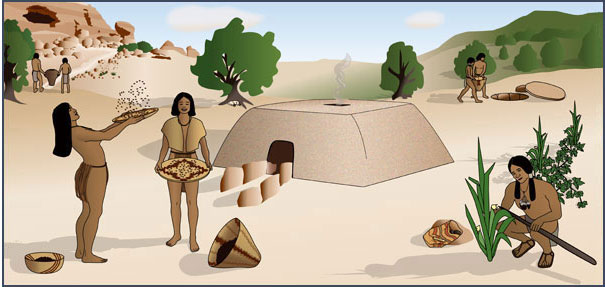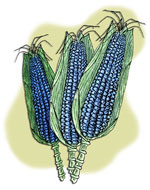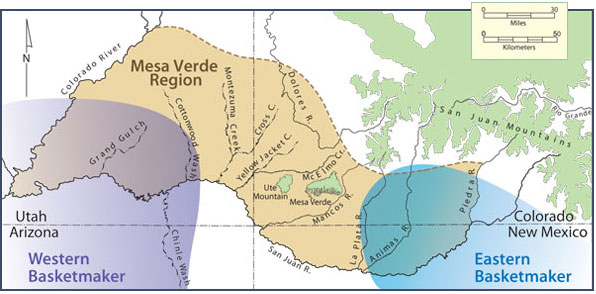Peoples of the Mesa Verde Region
Basketmaker II: 500 B.C. to A.D. 500Overview
For several thousand years, people have been on the move, walking to wherever the food happened to be. But as people become dependent on agriculture—especially corn—the seeds of Pueblo culture are planted, and life in the Mesa Verde region is forever changed. 
A Basketmaker II farmstead. To see what a Basketmaker II house looked like on the inside, go to Housing. A growing dependence on agriculture—especially corn—and the beginnings of a settled way of life marked the transition from the Archaic period to the Basketmaker II period. Although corn and squash were introduced onto the Colorado Plateau about 1000 to 2000 B.C, it was several centuries before people became dependent on agriculture, with corn becoming a major component of their diets. This shift in emphasis from hunting and gathering to farming required a similar shift in how people lived on the landscape: Specifically, they had to give up their nomadic existence for a more settled way of life that allowed them to stay close to home to tend their crops. So they began building more-permanent structures on farmsteads located close to good agricultural land. Because farming and settled life were two of the distinguishing characteristics of later Pueblo culture, most archaeologists consider the people of the Basketmaker II period to be the first Pueblo Indians. 
Dependence on agriculture is a hallmark of the Basketmaker II period. In the Mesa Verde region, Basketmaker peoples settled mostly in the western and eastern borderlands—archaeologists have found virtually no evidence of people living in the central part of the Mesa Verde region during this time. The Basketmakers who lived to the west (called the "Western Basketmakers") are thought by some archaeologists to have been the descendants of Archaic peoples who migrated to the area from southern Arizona. Those who lived to the east (called the "Eastern Basketmakers") may have been descendants of the original Archaic inhabitants of the Colorado Plateau. 
The Western and Eastern Basketmaker peoples settled in the borderlands, leaving the central part of the Mesa Verde region virtually uninhabited during the Basketmaker II period. The Western and Eastern Basketmakers were similar in some ways, but different in others. For example, archaeologists have identified differences in artifact and house-construction styles, and it is likely that the two groups spoke different languages. Archaeologists have also found evidence of conflict between the two peoples, so it is possible that the uninhabited area in the middle of the Mesa Verde region served as a buffer zone between them.
What happened to the Basketmaker I period? If people living during this time were the first Pueblo Indians, why do we call them "Basketmakers"? |
|
Acknowledgments | Illustration credits | To borrow, cite, or request permission | Please take our survey! Title page for Peoples of the Mesa Verde Region |
|
 DONATE TODAY
DONATE TODAY
